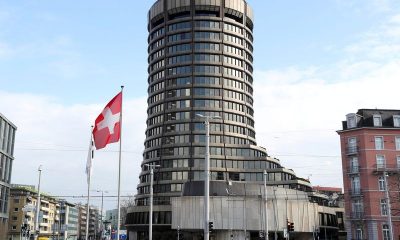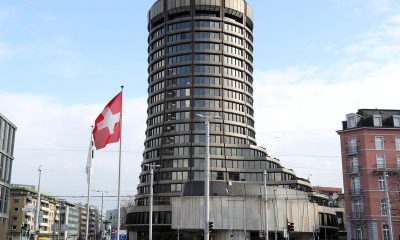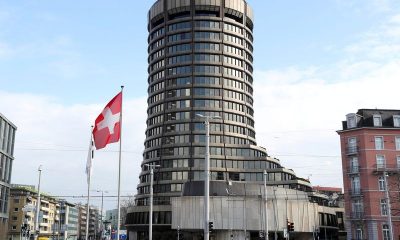Economy
U.S. factory orders miss expectations in May
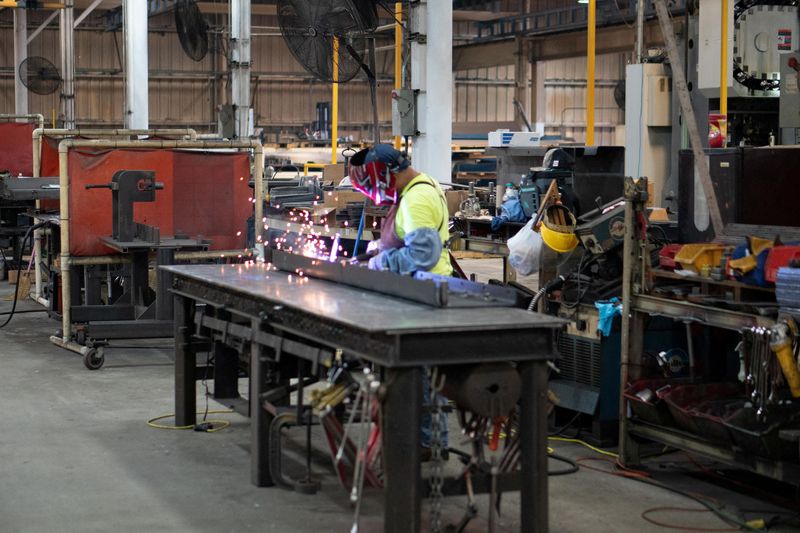
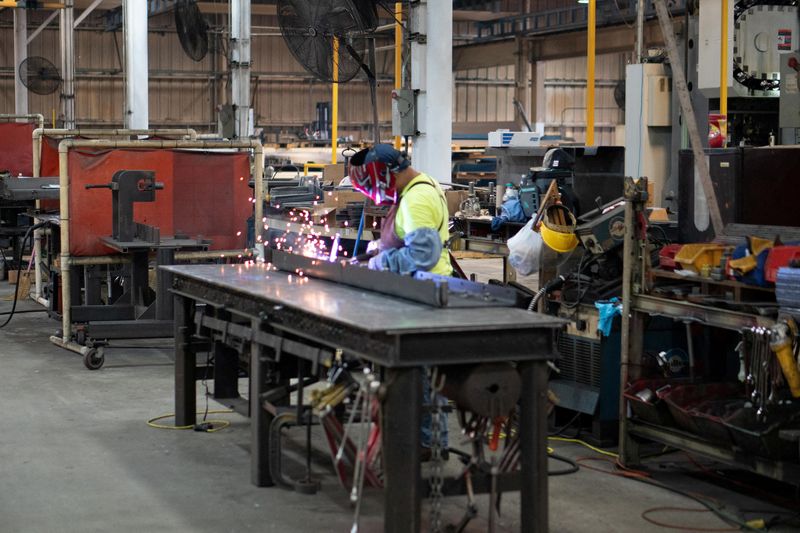
© Reuters. FILE PHOTO: Julio Ventura welds a screed bottom for a commercial class road paver at the Calder Brothers factory in Taylors, South Carolina, U.S., in this handout picture taken July 18, 2021. Brandon Granger/Calder Brothers Corporation/Handout via REUTERS
WASHINGTON(Reuters) – New orders for U.S.-made goods increased less than expected in May as a surge in civilian aircraft orders was partially offset by sluggishness elsewhere amid higher interest rates that are eroding demand.
Factory orders rose 0.3% after advancing by the same margin in April, the Commerce Department said on Wednesday. Economists polled by Reuters had forecast orders rising 0.8%. Orders increased 1.1% through May from a year earlier.
In addition to the higher interest rates, manufacturing, which accounts for 11.1% of the economy, is being constrained by spending shifting to services from goods, typically bought on credit as well as businesses carefully managing inventories in anticipation of weak demand.
The Institute for Supply Management’s manufacturing PMI dropped in June, marking the eighth straight month that the index stayed below the 50 threshold, which indicates contraction in manufacturing. That is the longest such stretch since the Great Recession.
Some pockets of strength remain, however, amid solid demand for goods like transportation equipment, machinery as well as electrical equipment, appliances and components.
Orders for transportation equipment increased 3.8% in May after accelerating 4.8% in the prior month. Civilian aircraft orders soared 32.8%, but motor vehicle orders fell 0.6%.
Orders for machinery surged 1.2%, while bookings for computers and electronic products rose 0.3%. Orders for electrical equipment, appliances and components rebounded 1.9%.
Excluding transportation, orders fell 0.5%. Shipments of manufactured goods rose 0.3%. The inventory of manufactured goods at factories fell 0.2%. Unfilled orders at factories increased 0.8%.
The Commerce Department also reported that orders for non-defense capital goods excluding aircraft, which are seen as a measure of business spending plans on equipment, rose by 0.7%, unrevised from last month’s estimate.
Shipments of these so-called core capital goods increased 0.3%. They were previously reported to have gained 0.2%. Business spending on equipment has contracted for two straight quarters, the first back-to-back declines since mid-2020.
Economy
Russian central bank says it needs months to make sure CPI falling before rate cuts -RBC


© Reuters. Russian Central Bank Governor Elvira Nabiullina attends a news conference in Moscow, Russia June 14, 2019. REUTERS/Shamil Zhumatov/File Photo
MOSCOW (Reuters) – Russia’s central bank will need two to three months to make sure that inflation is steadily declining before taking any decision on interest rate cuts, the bank’s governor Elvira Nabiullina told RBC media on Sunday.
The central bank raised its key interest rate by 100 basis points to 16% earlier in December, hiking for the fifth consecutive meeting in response to stubborn inflation, and suggested that its tightening cycle was nearly over.
Nabiullina said it was not yet clear when exactly the regulator would start cutting rates, however.
“We really need to make sure that inflation is steadily decreasing, that these are not one-off factors that can affect the rate of price growth in a particular month,” she said.
Nabiullina said the bank was taking into account a wide range of indicators but primarily those that “characterize the stability of inflation”.
“This will take two or three months or more – it depends on how much the wide range of indicators that characterize sustainable inflation declines,” she said.
The bank will next convene to set its benchmark rate on Feb. 16.
The governor also said the bank should have started monetary policy tightening earlier than in July, when it embarked on the rate-hiking cycle.
Economy
China identifies second set of projects in $140 billion spending plan


© Reuters. FILE PHOTO: Workers walk past an under-construction area with completed office towers in the background, in Shenzhen’s Qianhai new district, Guangdong province, China August 25, 2023. REUTERS/David Kirton/File Photo
SHANGHAI (Reuters) – China’s top planning body said on Saturday it had identified a second batch of public investment projects, including flood control and disaster relief programmes, under a bond issuance and investment plan announced in October to boost the economy.
With the latest tranche, China has now earmarked more than 800 billion yuan of its 1 trillion yuan ($140 billion) in additional government bond issuance in the fourth quarter, as it focuses on fiscal steps to shore up the flagging economy.
The National Development and Reform Commission (NDRC) said in a statement on Saturday it had identified 9,600 projects with planned investment of more than 560 billion yuan.
China’s economy, the world’s second largest, is struggling to regain its footing post-COVID-19 as policymakers grapple with tepid consumer demand, weak exports, falling foreign investment and a deepening real estate crisis.
The 1 trillion yuan in additional bond issuance will widen China’s 2023 budget deficit ratio to around 3.8 percent from 3 percent, the state-run Xinhua news agency has said.
“Construction of the projects will improve China’s flood control system, emergency response mechanism and disaster relief capabilities, and better protect people’s lives and property, so it is very significant,” the NDRC said.
The agency said it will coordinate with other government bodies to make sure that funds are allocated speedily for investment and that high standards of quality are maintained in project construction.
($1 = 7.1315 renminbi)
Economy
Russian central bank says it needs months to make sure CPI falling before rate cuts -RBC


© Reuters. Russian Central Bank Governor Elvira Nabiullina attends a news conference in Moscow, Russia June 14, 2019. REUTERS/Shamil Zhumatov/File Photo
MOSCOW (Reuters) – Russia’s central bank will need two to three months to make sure that inflation is steadily declining before taking any decision on interest rate cuts, the bank’s governor Elvira Nabiullina told RBC media on Sunday.
The central bank raised its key interest rate by 100 basis points to 16% earlier in December, hiking for the fifth consecutive meeting in response to stubborn inflation, and suggested that its tightening cycle was nearly over.
Nabiullina said it was not yet clear when exactly the regulator would start cutting rates, however.
“We really need to make sure that inflation is steadily decreasing, that these are not one-off factors that can affect the rate of price growth in a particular month,” she said.
Nabiullina said the bank was taking into account a wide range of indicators but primarily those that “characterize the stability of inflation”.
“This will take two or three months or more – it depends on how much the wide range of indicators that characterize sustainable inflation declines,” she said.
The bank will next convene to set its benchmark rate on Feb. 16.
The governor also said the bank should have started monetary policy tightening earlier than in July, when it embarked on the rate-hiking cycle.

 Forex3 years ago
Forex3 years agoForex Today: the dollar is gaining strength amid gloomy sentiment at the start of the Fed’s week

 Forex3 years ago
Forex3 years agoUnbiased review of Pocket Option broker

 Forex3 years ago
Forex3 years agoDollar to pound sterling exchange rate today: Pound plummeted to its lowest since 1985

 Forex3 years ago
Forex3 years agoHow is the Australian dollar doing today?

 Cryptocurrency3 years ago
Cryptocurrency3 years agoWhat happened in the crypto market – current events today

 World3 years ago
World3 years agoWhy are modern video games an art form?

 Commodities3 years ago
Commodities3 years agoCopper continues to fall in price on expectations of lower demand in China

 Economy3 years ago
Economy3 years agoCrude oil tankers double in price due to EU anti-Russian sanctions

